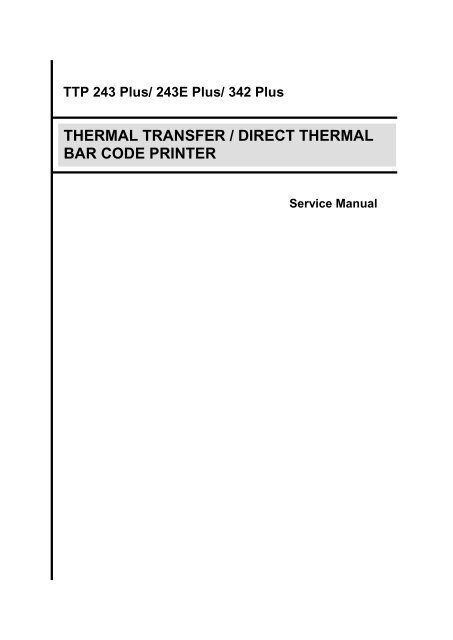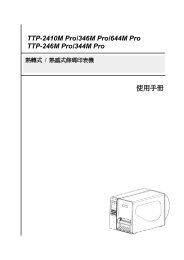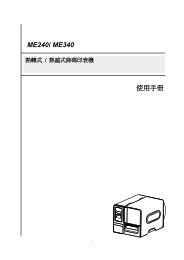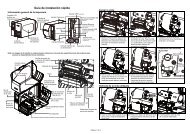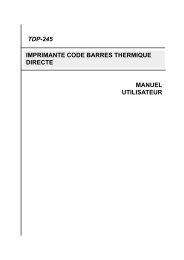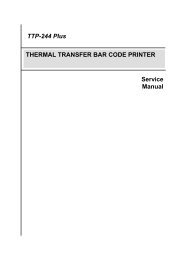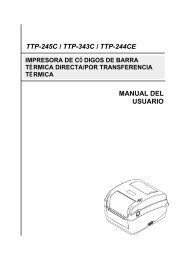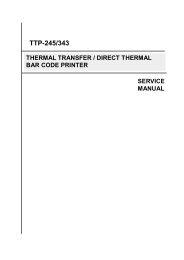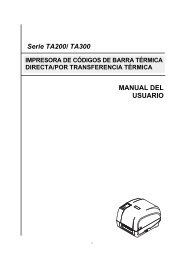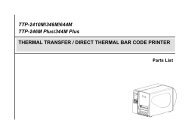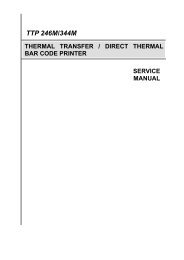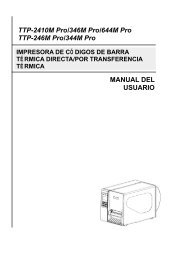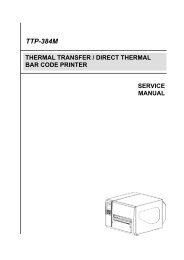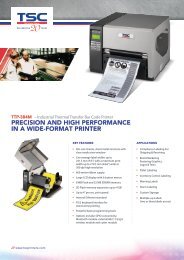You also want an ePaper? Increase the reach of your titles
YUMPU automatically turns print PDFs into web optimized ePapers that Google loves.
<strong>TTP</strong> <strong>243</strong> <strong>Plus</strong>/ <strong>243</strong>E <strong>Plus</strong>/ 342 <strong>Plus</strong><br />
THERMAL TRANSFER / DIRECT THERMAL<br />
BAR CODE PRINTER<br />
Service Manual<br />
<strong>TTP</strong>/TDP 244/342<br />
<strong>TTP</strong>/TDP 244
<strong>TTP</strong>-<strong>243</strong> <strong>Plus</strong>/ <strong>243</strong>E <strong>Plus</strong>/<br />
342 <strong>Plus</strong> Bar Code Printer<br />
Table of Contents<br />
1. FUNDAMENTALS ABOUT THE SYSTEM .................................................................. 1<br />
1.1 Features of the <strong>TTP</strong>-<strong>243</strong> Series ................................................................................. 1<br />
1.2 Model Naming Syntax ................................................................................................. 1<br />
1.3 Overview .................................................................................................................... 2<br />
1.3.1 Front View ........................................................................................................... 2<br />
1.3.2 Rear View ........................................................................................................... 3<br />
1.4 Basic Specifications .................................................................................................... 4<br />
1.5 Effective Print Area ..................................................................................................... 6<br />
1.6 Available Bar Codes ................................................................................................... 6<br />
1.7 Various Sensors ......................................................................................................... 7<br />
2. SUPPLY SPECIFICATIONS ............................................................................................. 9<br />
2.1 Types of Paper ........................................................................................................... 9<br />
2.2 Specifications ............................................................................................................. 9<br />
2.3 Ribbon Sizes and Shapes ........................................................................................ 11<br />
3. ELECTRONICS .............................................................................................................. 12<br />
3.1 Circuit Description .................................................................................................... 12<br />
3.2 MCU Pin Description ................................................................................................ 14<br />
3.3 Reset Circuit ............................................................................................................. 16<br />
3.4 Memory System........................................................................................................ 16<br />
3.5 Sensor&Key ............................................................................................................. 17<br />
3.6 Real-Time Clock Circuit ............................................................................................ 18<br />
3.7 Decode Circuit .......................................................................................................... 19<br />
3.8 Thermal Head Drive/ Protection and History Control Circuit ..................................... 21<br />
3.9 24V/5V Converter Circuit .......................................................................................... 22<br />
3.10 Stepping Motor And DC Motor Driver/ Protection Circuit ........................................ 23<br />
3.11 Communication (Serial & Parallel Port) Circuit........................................................ 24<br />
3.12 Cutter Drive Circuit ................................................................................................. 25<br />
3.13 Cutter & Peel Translate Board ................................................................................ 25<br />
3.14 Mainboard Replacement ......................................................................................... 26<br />
i
<strong>TTP</strong>-<strong>243</strong> <strong>Plus</strong>/ <strong>243</strong>E <strong>Plus</strong>/<br />
342 <strong>Plus</strong> Bar Code Printer<br />
3.15 Cutter, DC Motor, Stepping Motor Driver IC Replacement ...................................... 30<br />
4. MECHANISM .................................................................................................................. 31<br />
4.1 Cutter Installation ..................................................................................................... 31<br />
4.2 Print Head Replacement .......................................................................................... 32<br />
4.3 DC Motor Replacement ............................................................................................ 34<br />
4.4 Ribbon Rewind Spindle Encoder Replacement ........................................................ 34<br />
4.5 Felt Fabric Replacement .......................................................................................... 36<br />
4.6 Stepping Motor Replacement ................................................................................... 38<br />
4.7 Black Mark Sensor / Gap Sensor (Receiver) Replacement ...................................... 39<br />
4.8 Ribbon Sensor (Receiver) Replacement ................................................................... 39<br />
4.9 Ribbon Sensor (Transmitter) / Gap Sensor (Transmitter) Replacement ................... 42<br />
4.10 Platen Replacement ............................................................................................... 43<br />
5. TROUBLE SHOOTING ................................................................................................... 46<br />
5.1 Error Messages ........................................................................................................ 46<br />
5.2 Trouble Shooting ...................................................................................................... 47<br />
5.3 Calibrate the Gap Register ....................................................................................... 48<br />
5.4 Self-test .................................................................................................................... 48<br />
5.5 Ram Clear ................................................................................................................ 48<br />
5.6 Diagnosis Operation Procedure ................................................................................ 48<br />
5.7 Testing Sensors ....................................................................................................... 49<br />
5.8 Cleaning the Print Head ........................................................................................... 51<br />
ii
<strong>TTP</strong>-<strong>243</strong> <strong>Plus</strong>/ <strong>243</strong>E <strong>Plus</strong>/<br />
342 <strong>Plus</strong> Bar Code Printer<br />
1. FUNDAMENTALS ABOUT THE SYSTEM<br />
1.1 Features of the <strong>TTP</strong>-<strong>243</strong> Series<br />
1. This bar code printer prints bar codes, characters, logos, on various types of labels and tickets<br />
by direct thermal or thermal transfer printing.<br />
2 This printer adopts a “BASIC-like” high level programming language to help users programme<br />
the desired label forms with ease.<br />
3. This bar code printer can be connected to a personal computer or an optional LCD keyboard<br />
to execute the programs downloaded in the printer‟s memory. The printer is equipped with the<br />
following standard devices: black mark sensor, peel off module and real time clock.<br />
4. This bar code printer provides a selection of optional features, including cutter module,<br />
memory module, portable LCD keyboard, etc.<br />
5. The user friendly labeling software package is bundled with printer.<br />
1.2 Model Naming Syntax<br />
T T P – 2 4 3<br />
(1) (2) (3) (4)<br />
(1) Print method:<br />
<strong>TTP</strong> – Thermal Transfer Printing<br />
TDP – Thermal Direct Printing<br />
(2) Resolution of print head (DPI)<br />
(3) Maximum print width (Inch)<br />
(4) Maximum print speed (Inch/Sec)<br />
1
<strong>TTP</strong>-<strong>243</strong> <strong>Plus</strong>/ <strong>243</strong>E <strong>Plus</strong>/<br />
342 <strong>Plus</strong> Bar Code Printer<br />
1.3 Overview<br />
1.3.1 Front View<br />
Operation Panel<br />
Top Cover<br />
Cover Release Button<br />
Fig. 1.1 Front View<br />
Front Panel<br />
Note: The one difference between <strong>TTP</strong> model and TDP model is the ribbon mechanism.<br />
2
<strong>TTP</strong>-<strong>243</strong> <strong>Plus</strong>/ <strong>243</strong>E <strong>Plus</strong>/<br />
342 <strong>Plus</strong> Bar Code Printer<br />
1.3.2 Rear View<br />
Label<br />
Entrance<br />
(External<br />
Mount Use)<br />
Power<br />
Switch<br />
Centronics Interface<br />
RS-232 Interface<br />
DC Power Jack<br />
Fig. 1.2 Rear view<br />
3
<strong>TTP</strong>-<strong>243</strong> <strong>Plus</strong>/ <strong>243</strong>E <strong>Plus</strong>/<br />
342 <strong>Plus</strong> Bar Code Printer<br />
1.4 Basic Specifications<br />
• Thermal transfer and direct thermal printing<br />
• High dot density printing (203 dots/inch)<br />
• Selectable print speeds at 1.5”, 2.0” or 3.0” per second<br />
• Supports parallel and serial interface<br />
• Maximum media width up to 4.4” (114 mm)<br />
• Adjustable label edge guide<br />
• International character sets<br />
• Print area:<strong>TTP</strong>-<strong>243</strong> <strong>Plus</strong>/<strong>243</strong>E <strong>Plus</strong>:4.09” W x 39” L;<strong>TTP</strong>-342 <strong>Plus</strong>:4.09”W x 18”L (without<br />
any file downloaded in the printer memory)<br />
• User selectable bar code ratios and heights<br />
• Prints on labels or tickets<br />
• Equipped with black mark sensor<br />
• Equipped with Real Time Clock (<strong>243</strong> <strong>Plus</strong> only)<br />
• Comes with self-peeling function (<strong>243</strong> <strong>Plus</strong> only)<br />
• Buzzer provided to warn of possible errors (<strong>243</strong> <strong>Plus</strong> only)<br />
• Label stock and thermal transfer ribbon are easy to install<br />
• Internal label print counter<br />
• Self test and hex dump mode<br />
• Downloadable fonts from label design software<br />
Electronics/Communication Specifications<br />
• Electrical<br />
CPU: Hitachi SH2 7040<br />
TPH: ROHM 4” KF-2004-GC17B<br />
Stepping Motor: Mitsumi<br />
DC Motor: DC24V<br />
Memory:<br />
─DRAM: 2 Mb<br />
─Flash: 2 Mb<br />
Adapter 100~240VAC10%, 50~60Hz<br />
Regulations: CE, FCC,TÜ V-GS<br />
• Communications Interface:<br />
Serial port: RS-232C (DB-9) at 2400, 4800, 9600 or 19200 baud rate<br />
─Word Length: 7 or 8 data bits, 1 or 2 stop bits, selectable parity<br />
─Handshaking: XON/XOFF and DSR/DTR<br />
Parallel port: Standard parallel interface<br />
Input Buffer: 60KB<br />
• RS-232 Interface Pin Configuration:<br />
4
<strong>TTP</strong>-<strong>243</strong> <strong>Plus</strong>/ <strong>243</strong>E <strong>Plus</strong>/<br />
342 <strong>Plus</strong> Bar Code Printer<br />
Host Function 9 Pin 25 Pin 9 Pin Printer Function<br />
1 +5V<br />
RxD 2 3 2 TxD<br />
TxD 3 2 3 RxD<br />
DTR 4 20 4 DSR<br />
GND 5 7 5 GND<br />
DSR 6 6 6 RDY<br />
RTS 7 4 7 N/C<br />
CTS 8 5 8 RDY<br />
9 +5V<br />
5
<strong>TTP</strong>-<strong>243</strong> <strong>Plus</strong>/ <strong>243</strong>E <strong>Plus</strong>/<br />
342 <strong>Plus</strong> Bar Code Printer<br />
1.5 Effective Print Area<br />
1.6 Available Bar Codes<br />
• Code 39<br />
• Code 93<br />
• Code 128 UCC<br />
• Code 128, Subsets A, B, and C<br />
• Codabar<br />
• Interleaved 2 of 5<br />
• EAN-8, EAN-13, EAN-128<br />
• UPC-A, UPC-E<br />
• EAN and UPC with 2 or 5 digits add-on<br />
• UPC Shipping container code<br />
• Postnet<br />
• Maxicode<br />
• PDF-417<br />
• DataMatrix<br />
Label/Ticket Length 12mm~2286mm<br />
Effective Print<br />
10mm~2284mm<br />
Length<br />
Label/Ticket Width 25mm~103mm<br />
Effective Print Width 23mm~101mm<br />
No Print Area 1mm<br />
6
<strong>TTP</strong>-<strong>243</strong> <strong>Plus</strong>/ <strong>243</strong>E <strong>Plus</strong>/<br />
342 <strong>Plus</strong> Bar Code Printer<br />
1.7 Various Sensors<br />
Feed Gap Sensor<br />
The feed gap sensor detects a label gap to locate the starting print position of the next<br />
label. The sensor is mounted 4 mm off the center line of the main mechanism.<br />
.<br />
In case of Label<br />
Black Mark Sensor<br />
The black mark sensor locates the position of label by emitting infrared rays onto the<br />
black mark at the back of the ticket. The sensor is mounted 5.75 mm off the center line<br />
of the ticket roll width on the mechanism.<br />
7
<strong>TTP</strong>-<strong>243</strong> <strong>Plus</strong>/ <strong>243</strong>E <strong>Plus</strong>/<br />
342 <strong>Plus</strong> Bar Code Printer<br />
In case of Ticket<br />
The default sensor position is (1) as shown on the figure below. To change to the (2)<br />
position, the customer should notify the manufacturer in advance. There can be only<br />
one position for the sensor. Once the sensor position is agreed upon, it can not be<br />
changed afterwards.<br />
Ribbon End Sensor<br />
The sensor detects the end portion of the ribbon. The ribbon end must be transparent.<br />
Label End Sensor<br />
The sensor detects the end portion of the label.<br />
Peel off Sensor<br />
The sensor detects the backing paper of a label.<br />
Ribbon encoder<br />
The encoder is used to detect if the ribbon is broken.<br />
8
<strong>TTP</strong>-<strong>243</strong> <strong>Plus</strong>/ <strong>243</strong>E <strong>Plus</strong>/<br />
342 <strong>Plus</strong> Bar Code Printer<br />
2. SUPPLY SPECIFICATIONS<br />
2.1 Types of Paper<br />
Two types of media are available for <strong>TTP</strong>-<strong>243</strong>: label and ticket.<br />
In <strong>TTP</strong>-<strong>243</strong>, there are two types of sensors for paper: gap sensor and black mark<br />
sensor.<br />
Label and ticket can be further classified into direct thermal type or thermal transfer<br />
type.<br />
2.2 Specifications<br />
Items<br />
Max.114mm<br />
Paper Width<br />
Min. 25mm<br />
Length (Pitch) 12~2286mm<br />
Paper<br />
0.20 mm<br />
Thickness<br />
Paper Weight Max 240 g/m 2<br />
Max. Roll<br />
Diameter<br />
(1” core)<br />
Label<br />
Inner roll diameter. Max 4.3” (110mm)<br />
External roll diameter. Max 8.4”<br />
(214mm)<br />
Roll Up Method Print surface wound outside as<br />
standard<br />
Paper Core ID. 25.7±0.3mm<br />
Note:<br />
(1). The width and thickness quoted above are said of the label plus its backing paper.<br />
(2). Likewise, the approval of label entails that of its backing paper.<br />
(3). In the peel off mode, the minimum pitch is 35mm.<br />
(4). In the cutter mode, it is required the paper be wound outside. Otherwise, paper jam<br />
tends to result.<br />
(5). In the cutter mode, the paper thickness is 0.2 mm at maximum, and the paper weight is<br />
100 g/m 2 at maximum.<br />
(6). Paper shape is as shown on next page.<br />
(7) Tag is 0.2mm in thickness, and is less than 100g/m 2 in weight.<br />
9
<strong>TTP</strong>-<strong>243</strong> <strong>Plus</strong>/ <strong>243</strong>E <strong>Plus</strong>/<br />
342 <strong>Plus</strong> Bar Code Printer<br />
10
<strong>TTP</strong>-<strong>243</strong> <strong>Plus</strong>/ <strong>243</strong>E <strong>Plus</strong>/<br />
342 <strong>Plus</strong> Bar Code Printer<br />
2.3 Ribbon Sizes and Shapes<br />
Item<br />
Ribbon shape<br />
Ribbon width<br />
Ribbon winding width<br />
Leading tape<br />
End tape<br />
Max. ribbon OD.<br />
Winding method<br />
Specifications<br />
Spool type<br />
Max. 110mm<br />
Min. 40mm<br />
Max. 110mm<br />
Min. 40mm<br />
Polyester film, 3355mm long<br />
Polyester film (transparent), 2505mm<br />
long<br />
67mm<br />
Ink surface to be wound outside<br />
Note: The maximum length of ribbon depends on its thickness and core outside diameter.<br />
The formula below defines the correlation between ribbon roll length and ribbon core<br />
diameter.<br />
2 2<br />
(D d ) <br />
L =<br />
, where<br />
4t<br />
L = Ribbon length<br />
D = Max. roll diameter<br />
d = Ribbon core outside diameter<br />
t = Ribbon thickness<br />
11
<strong>TTP</strong>-<strong>243</strong> <strong>Plus</strong>/ <strong>243</strong>E <strong>Plus</strong>/<br />
342 <strong>Plus</strong> Bar Code Printer<br />
3. ELECTRONICS<br />
3.1 Circuit Description<br />
Fig. 3.1 MCU Circuit Diagram<br />
The above is the MCU circuit diagram.<br />
The main board includes seven system blocks:<br />
A: MCU & Decode System<br />
B. Memory System<br />
C. Motor System (stepping motor, DC motor and cutter block)<br />
D. Print head System<br />
E. Communication System (serial & parallel port block)<br />
F. Sensor & Key System<br />
12
<strong>TTP</strong>-<strong>243</strong> <strong>Plus</strong>/ <strong>243</strong>E <strong>Plus</strong>/<br />
342 <strong>Plus</strong> Bar Code Printer<br />
G. Power System<br />
The figure below shows the PCB system area.<br />
Communication Port<br />
Motor<br />
System<br />
Memory<br />
Decoder<br />
System<br />
Print<br />
Head<br />
Cutter<br />
System<br />
Real Time<br />
Clock<br />
Memory<br />
System<br />
13<br />
External<br />
Memory<br />
Connector<br />
Power<br />
System
<strong>TTP</strong>-<strong>243</strong> <strong>Plus</strong>/ <strong>243</strong>E <strong>Plus</strong>/<br />
342 <strong>Plus</strong> Bar Code Printer<br />
3.2 MCU Pin Description<br />
Port I/O Initial High Low Function Instruction<br />
PA0 I Pull Up RXD0 RXD for RS232<br />
PA1 O TXD0 TXD for RS232<br />
PA2 I Pull Up PA2 RTS for RS232<br />
PA3 O PA3 CTS for RS232<br />
PA4 O TXD1 DI for TPH<br />
PA5 O SCK1 CLK for TPH<br />
PA6 O Pull Up Active /CS2 /CS2<br />
PA7 O Pull Up Active /CS3 /CS3<br />
PA8 I Active IRQ2 Power down<br />
PA9 I Pull Up Active IRQ3 USB_INT<br />
PA10 O Pull Up Active /CS0 /CS0<br />
PA11 O Pull Up Active /CS1 /CS1<br />
PA12 O /WRL /WRL<br />
PA13 O /WRH No use<br />
PA14 O /RD /RD<br />
PA15 O Pull Up Enable PA15 /LAT for TPH<br />
PB0 O A16 A16<br />
PB1 O A17 A17<br />
PB2 O /RAS /RAS<br />
PB3 O /CASL /CASL<br />
PB4 O /CASH /CASH<br />
PB5 O RDWR RDWR<br />
PB6 O A18 A18<br />
PB7 O A19 A19<br />
PB8 O A20 A20<br />
PB9 O A21 A21<br />
PC0~PC15 O A0~A15 A0~A15<br />
PD0~PD15 I/O D0~D15 D0~D15<br />
PE0 O PWM Enable TIOC0A GAP LEVEL<br />
PE1 I Pull Up PE1 KEY3<br />
PE2 I Pull Up Enable PE2 CASE OPEN<br />
PE3 I Pull Up Enable PE3 /STTOBE for Centronic port<br />
PE4 O PWM Enable TIOC1A DCM for DC motor enable<br />
PE5 O Pull Up Enable PE5 STB1 for TPH<br />
PE6 I Pull Up Enable PE6 DC SENS for DC sensor<br />
PE7 O Pull Up Enable PE7 STB2 for TPH<br />
PE8 I Pull Up PE8 KEY2<br />
PE9 I Pull Up PE9 KEY1<br />
PE10 O Pull Up Enable PE10 STB3 for TPH<br />
PE11 I Pull Up Enable PE11 CT SENS for cutter sensor<br />
PE12 I/O Pull Up PE12 SUSPEND for USB<br />
PE13 O Pull Up Enable PE13 STB4 for TPH<br />
PE14 I/O PE14 RTC I/O<br />
PE15 I Pull Up Enable PE15 HEAD SENS<br />
PF0 I PF0 Vdet for TPH Voltage detect<br />
PF1 I PF1 TM for TPH temperture<br />
14
<strong>TTP</strong>-<strong>243</strong> <strong>Plus</strong>/ <strong>243</strong>E <strong>Plus</strong>/<br />
342 <strong>Plus</strong> Bar Code Printer<br />
PF2 I Enable PF2 MEM load & Hardware version<br />
PF3 I PF3 CT DETECT<br />
PF4 I PF4 PEEL SENS<br />
PF5 I PF5 RIBBON SENS<br />
PF6 I PF6 BM SENS<br />
PF7 I PF7 GAP SENS<br />
NMI I Pull Up NMI No use<br />
/RESETP I Pull Up Active /RESETP /RESET<br />
/WDTOVF O /WDTOVF No use<br />
IRQ0: NO USE<br />
IRQ1: NO USE<br />
IRQ2: POWER DOWN<br />
IRQ3: USB_INT<br />
IRQ4: NO USE<br />
IRQ5: NO USE<br />
IRQ6: NO USE<br />
IRQ7: NO USE<br />
Other define<br />
1. System Crystal is 16 MHz.<br />
2. USB Crystal is 48MHz.<br />
3. RTC Crystal 32.768KHz.<br />
4. MCU mode is mode 1.(16-bit space) ( MD0 is high, MD1 is low. )<br />
5. Clock mode is PLL ON x 4. (MD2 is low, MD3 is High.)<br />
15
<strong>TTP</strong>-<strong>243</strong> <strong>Plus</strong>/ <strong>243</strong>E <strong>Plus</strong>/<br />
342 <strong>Plus</strong> Bar Code Printer<br />
3.3 Reset Circuit<br />
Fig. 3.3 Reset Circuit<br />
This is the reset circuit .The TS809CXA IC outputs the system reset signal of “LOW”<br />
when the driving voltage is lower than 4.63V (Typical),U31 NO use.<br />
3.4 Memory System<br />
Fig. 3.4 FLASH ROMS and DRAM Diagram<br />
This is the memory circuit. The U8 & U9 are 2M Byte FLASH ROM and U10 is 2M Byte<br />
DRAM .<br />
16
<strong>TTP</strong>-<strong>243</strong> <strong>Plus</strong>/ <strong>243</strong>E <strong>Plus</strong>/<br />
342 <strong>Plus</strong> Bar Code Printer<br />
3.5 Sensor&Key<br />
Fig. 3.5 Sensor&Key<br />
JP1 is the connector which connects to the LEDs and Keys. The signal of LED is High when<br />
the LED is bright; otherwise, it is low.<br />
JP2 is the connector of the head open sensor. The Head open sensor is a micro switch. the<br />
voltage is High when the print head open; otherwise, it is low.<br />
The signal of the key is “LOW” when the keys is press; otherwise, t is “HIGH”.<br />
P4 is the connector which connects to the block mark sensor.<br />
The block mark sensor is a reflect in sensor. the block mark sensor signal voltage is “HIGH<br />
“ when the block mark is detected; otherwise, it is “LOW”.<br />
JP5 is the connector which connects to the gap sensor and the gap emitter level. The gap<br />
level is a emitter source intensity control signal. signal. The gap sensor is a penetrable<br />
sensor. the gap sensor signal voltage is low when the gap is detected; otherwise, it is high.<br />
JP7 is the connector of the HEAD-OPEN sensor. When the printhead open,<br />
The HEAD SENS signal is “High” ; When the printhead close, The HEAD SENS Signal<br />
is ”LOW”.<br />
17
<strong>TTP</strong>-<strong>243</strong> <strong>Plus</strong>/ <strong>243</strong>E <strong>Plus</strong>/<br />
342 <strong>Plus</strong> Bar Code Printer<br />
3.6 Real-Time Clock Circuit<br />
HT1381 is serial time Keeper.<br />
Fig. 3.6 Real-Time Clock Circuit<br />
18
<strong>TTP</strong>-<strong>243</strong> <strong>Plus</strong>/ <strong>243</strong>E <strong>Plus</strong>/<br />
342 <strong>Plus</strong> Bar Code Printer<br />
3.7 Decode Circuit<br />
19
<strong>TTP</strong>-<strong>243</strong> <strong>Plus</strong>/ <strong>243</strong>E <strong>Plus</strong>/<br />
342 <strong>Plus</strong> Bar Code Printer<br />
CS0: (0000 0000 ~ 003F FFFF)<br />
CS1: (0040 0000 ~ 007F FFFF)<br />
CS2: (0080 0000 ~ 00BF FFFF)<br />
CS3: (00C0 0000 ~ 0FFF FFFF)<br />
ROM1: (0000 0000 ~ 001F FFFF)<br />
ROM2: (0020 0000 ~ 003F FFFF)<br />
Memory card :(0040 0000~007F FFFF)<br />
Download ROM: (0800 0000 ~ 09F FFFF)<br />
DRAM: (0100 0000~011F~FFFF)<br />
Other Map<br />
Address Bit Function<br />
00C0 0000<br />
MOTOR DATA<br />
00D0 0000<br />
/USB<br />
00E0 0000<br />
/CENTRONIC<br />
DATA<br />
00F0 0000<br />
OTHER ENABLE<br />
0 PHASE1<br />
1 PHASE2<br />
2 I0<br />
3 I1<br />
4 /CT EN<br />
5 DC PHASE<br />
6 TPH EN<br />
7 BUZZER<br />
0 USB_D0<br />
1 USB_D1<br />
2 USB_D2<br />
3 USB_D3<br />
4 USB_D4<br />
5 USB_D5<br />
6 USB_D6<br />
7 USB_D7<br />
0 P_D0<br />
1 P_D1<br />
2 P_D2<br />
3 P_D3<br />
4 P_D4<br />
5 P_D5<br />
6 P_D6<br />
7 P_D7<br />
0 LED1<br />
1 LED2<br />
2 LED3<br />
3 PE<br />
4 /SLCT<br />
5 /ERROR<br />
6 /RTC RESET<br />
7 RTC CLK<br />
20
<strong>TTP</strong>-<strong>243</strong> <strong>Plus</strong>/ <strong>243</strong>E <strong>Plus</strong>/<br />
342 <strong>Plus</strong> Bar Code Printer<br />
3.8 Thermal Head Drive/ Protection and History Control Circuit<br />
Fig. 3.9 Thermal Head Drive/ Protection and History Control Circuit<br />
This is the thermal head drive circuit. CLK and /LAT connected to thermal head control clock<br />
and data latch respectively. TPH_EN controls the DC24V voltage of the thermal head.<br />
When TPH_EN is “LOW”, the thermal head will be separated from 24V (VMM). STB1-STB4<br />
determines whether to heat the thermal head or not. DI sends the printer data to the print<br />
head. TM is the temperature for thermal head. Vdet feeds back the voltage and<br />
compensates the heat time for voltage accuracy when printing.<br />
21
<strong>TTP</strong>-<strong>243</strong> <strong>Plus</strong>/ <strong>243</strong>E <strong>Plus</strong>/<br />
342 <strong>Plus</strong> Bar Code Printer<br />
3.9 24V/5V Converter Circuit<br />
Fig. 3.10 24V/5V Converter Circuit<br />
Figure 3.9 is the DC-TO-DC (DC24V to DC 5V) converter circuit, which is a step-down<br />
system circuit structure. U24 is the DC-TO-DC converter IC, which can convert voltage by<br />
using PWM control mode. The output voltage is dependent on R3 and R4.<br />
22
<strong>TTP</strong>-<strong>243</strong> <strong>Plus</strong>/ <strong>243</strong>E <strong>Plus</strong>/<br />
342 <strong>Plus</strong> Bar Code Printer<br />
3.10 Stepping Motor And DC Motor Driver/ Protection Circuit<br />
Fig. 3.10 Stepping Motor And DC Motor Driver/ Protection Circuit<br />
This is the Stepping Motor Drive. Connector JP12 sends the pattern as shown in table1. The<br />
status of I0 & I1 determines the stepping motor power level, the power level pattern is<br />
shown in table2. PHASE1 and PHASE2 determine the pattern of stepping motor drive circuit.<br />
For example, the sequence of PHASE1/PHASE2 in full step mode is 0/0 → 0/1 → 1/1 →<br />
1/0.<br />
Step Pin on JP12 1 2 3 4 PHASE<br />
1 ON ON ON A<br />
2 ON ON /A<br />
3 ON ON ON /B<br />
4 ON ON B<br />
Table1 Stepping Motor Pattern<br />
MOTOR CURRENT I0 I1<br />
HIGH LEVEL 100% L L<br />
MEDIUM LEVEL 60% H L<br />
LOW LEVEL 20% L H<br />
ZERO CURRENT 0% H H<br />
Table2 Stepping motor power pattern<br />
The power of DC motor is on when DCM pin is at ‟LOW‟ level. DC-PHASE determines the<br />
DC motor run direction (forward or backward).<br />
23
<strong>TTP</strong>-<strong>243</strong> <strong>Plus</strong>/ <strong>243</strong>E <strong>Plus</strong>/<br />
342 <strong>Plus</strong> Bar Code Printer<br />
3.11 Communication (Serial & Parallel Port) Circuit<br />
Fig. 3.11 Parallel port and RS-232 Circuit<br />
The RS-232 Circuit is for use with the externally connected personal computer and<br />
keyboard unit. JP13 connects to PC serial port through the RS-232 cable. RxD is the<br />
data receive pin of MCU. CTS is the Clear To Send of MCU, which sends the signal<br />
from the external device. TxD is the data output pin of MCU. RTS is the Request To<br />
Send signal which MCU sends to the external device.<br />
The parallel port circuit is for use with the externally connected personal computer<br />
parallel port through the printer cable. When PC‟s strobe signal comes in, the printer<br />
responds the „busy status‟ until it reads the data from parallel port. Printer will respond<br />
the „error signal‟ to PC when it is in error status.<br />
24
<strong>TTP</strong>-<strong>243</strong> <strong>Plus</strong>/ <strong>243</strong>E <strong>Plus</strong>/<br />
342 <strong>Plus</strong> Bar Code Printer<br />
3.12 Cutter Drive Circuit<br />
Fig. 3.12 Cutter Drive Circuit<br />
This is the cutter drive circuit. The RESET signal is 1 when the printer is turned on.<br />
/CT_EN controls the activation of the cutter. The cutter is activated when CUTTER<br />
signal is “low”. The sensor of cutter sends the “Hi-Lo” signal to MCU through CT_SENS<br />
that detects the action of cutter.<br />
3.13 Cutter & Peel Translate Board<br />
Cutter and peel connector circuit.<br />
JP1 connect to peel module.<br />
JP2 connect to cutter module.<br />
JP3 connect to main board JP3.<br />
25
<strong>TTP</strong>-<strong>243</strong> <strong>Plus</strong>/ <strong>243</strong>E <strong>Plus</strong>/<br />
342 <strong>Plus</strong> Bar Code Printer<br />
3.14 Mainboard Replacement<br />
1. Turn off the printer power.<br />
2. Remove the power cord and RS-232 and/or parallel port cable.<br />
3. Open the top cover of the printer.<br />
4. Remove the printer front panel.<br />
Fig. 3.14 Remove the front cover<br />
in the direction of the arrows<br />
5. Remove the two screws and the metal cover.<br />
Screws<br />
Metal Cover<br />
Fig. 3.15 Remove the screws<br />
and metal cover<br />
26
<strong>TTP</strong>-<strong>243</strong> <strong>Plus</strong>/ <strong>243</strong>E <strong>Plus</strong>/<br />
342 <strong>Plus</strong> Bar Code Printer<br />
6. Release the cable tie and remove the peel-off sensor connector.<br />
Cable Tie<br />
Peel-Off Sensor<br />
Connector<br />
Cutter Connector<br />
Fig. 3.16 Cable tie and peel-off sensor connector<br />
7. Remove the screws on the lower left and lower right corners of main mechanism.<br />
Fig. 3.17 Remove the screws in the lower left, lower<br />
right corners of the main mechanism.<br />
27
<strong>TTP</strong>-<strong>243</strong> <strong>Plus</strong>/ <strong>243</strong>E <strong>Plus</strong>/<br />
342 <strong>Plus</strong> Bar Code Printer<br />
8. Remove the four screws of the internal label roll mount.<br />
Fig. 3.18 Remove screws of the label roll mount<br />
9. Move the mechanism about 5 mm in the label feed direction.<br />
10. Take out the internal label roll mount and remove the connector.<br />
Push Button<br />
Connector<br />
Ground Wire<br />
Fig. 3.19 Take out the internal label roll<br />
mount and remove the connector<br />
28
<strong>TTP</strong>-<strong>243</strong> <strong>Plus</strong>/ <strong>243</strong>E <strong>Plus</strong>/<br />
342 <strong>Plus</strong> Bar Code Printer<br />
11. Remove the screw of ground wire on the mainboard.<br />
12. Remove all connectors on the mainboard. (JP1, JP2, JP3, JP4, JP5, JP6, JP7, JP11, JP7,<br />
JP9, JP12)<br />
Connector<br />
JP1<br />
JP2<br />
JP3<br />
JP4<br />
JP5<br />
JP6<br />
JP7<br />
JP8<br />
JP9<br />
JP12<br />
Description<br />
External button, LED connector<br />
Ribbon sensor receiver connector<br />
Cutter and Peel off sensor connector<br />
Black mark sensor connector<br />
Gap / ribbon transmit sensor<br />
connector<br />
DC motor and encoder connector<br />
TPH head up switch connector<br />
Memory cartridge connector<br />
TPH connector<br />
Stepping motor connector<br />
13. Take out the mechanism.<br />
14. Remove the rest three screws on the mainboard.<br />
Fig. 3.20 Upper-Left, Upper-Right, Lower-Right Corner Screw<br />
15. Replace the mainboard.<br />
16. Reassemble the mechanism and internal label roll mount in the reverse procedures of the removal.<br />
29
<strong>TTP</strong>-<strong>243</strong> <strong>Plus</strong>/ <strong>243</strong>E <strong>Plus</strong>/<br />
342 <strong>Plus</strong> Bar Code Printer<br />
3.15 Cutter, DC Motor, Stepping Motor Driver IC Replacement<br />
FLASH<br />
Memory<br />
Stepping<br />
Motor Driver IC<br />
DC Motor<br />
Driver IC<br />
Fig. 3.22 Driver IC Locations<br />
Cutter Driver IC<br />
If the DC motor (ribbon rewind spindle) rotates back and forth, please check the DC<br />
motor driver IC, make sure it is firmly inserted in the IC socket and is not burned.<br />
If the cutter does not work, please check that the software or program has been<br />
switched to the cutter mode. If the cutter still does not function, please check the cutter<br />
driver IC, make sure it is firmly inserted in the IC socket and is not burned.<br />
The stepping motor driver IC is burned if the stepping motor makes noises but does not<br />
feed labels when the FEED key is pressed. In this case, please replace with a new<br />
driver IC.<br />
Use an IC clamp to remove the damaged IC.<br />
30
<strong>TTP</strong>-<strong>243</strong> <strong>Plus</strong>/ <strong>243</strong>E <strong>Plus</strong>/<br />
342 <strong>Plus</strong> Bar Code Printer<br />
4. MECHANISM<br />
4.1 Cutter Installation<br />
1. Turn off the printer power.<br />
2. Open the top cover of the printer.<br />
3. Remove the printer front panel slowly and carefully. (Cf. Fig. 3.14)<br />
4. Remove the two screws and the metal cover. (Cf. Fig. 3.15)<br />
5. Release the cable tie and remove the peel-off sensor connector. (Cf. Fig. 3.16)<br />
6. Remove the peel-off sensor connector.<br />
7. Plug in the cutter connector.<br />
8. Insert the right and left side flange of cutter into the slot.<br />
Left Flange<br />
Right Flange<br />
Fig. 4.1 Cutter Installation<br />
9. Fasten the cutter from the bottom of the printer with the provided screw.<br />
10. Make sure no screws or other parts are left in the printer.<br />
11. Reassemble the mechanism and internal label roll mount in the reverse procedures of the<br />
removal.<br />
31
<strong>TTP</strong>-<strong>243</strong> <strong>Plus</strong>/ <strong>243</strong>E <strong>Plus</strong>/<br />
342 <strong>Plus</strong> Bar Code Printer<br />
4.2 Print Head Replacement<br />
1. Turn off the printer power.<br />
2. Remove the RS-232 cable and power cord.<br />
3. Open the top cover.<br />
4. Remove the ribbon and label roll.<br />
5. Open the print carriage.<br />
6. Remove the screw at the top front center of the mechanism, as shown.<br />
7. Disconnect the print head cable.<br />
Fig. 4.2 The Print Head Screw<br />
Print Head<br />
Cable<br />
Key of the<br />
Connector<br />
Print Head<br />
Connector<br />
Fig. 4.3 Printhead and the Cable<br />
32
<strong>TTP</strong>-<strong>243</strong> <strong>Plus</strong>/ <strong>243</strong>E <strong>Plus</strong>/<br />
342 <strong>Plus</strong> Bar Code Printer<br />
Note: The key of connector must be positioned upward.<br />
Do not touch the elements of the print head.<br />
Do not disassemble the print head.<br />
8. Tidy up the cable so that it does not protrude or interfere with the ribbon.<br />
9. Reassemble the removed parts in the reverse order of removal.<br />
33
<strong>TTP</strong>-<strong>243</strong> <strong>Plus</strong>/ <strong>243</strong>E <strong>Plus</strong>/<br />
342 <strong>Plus</strong> Bar Code Printer<br />
4.3 DC Motor Replacement<br />
1. Turn off the printer power.<br />
2. Remove the power cord and RS-232 and/or parallel port cable.<br />
3. Open the top cover of the printer.<br />
4. Remove the printer front panel. (Cf. Fig. 3.14)<br />
5. Remove the two screws and the metal cover. (Cf. Fig. 3.15)<br />
6. Release the cable tie and remove the peel-off sensor connector. (Cf. Fig. 3.16)<br />
7. Remove the screw on the PCB of peel-off and cutter connector.<br />
8. Remove the screws in the lower left, lower right corners of the main mechanism. (Cf. Fig. 3.17)<br />
9. Remove all four screws of the internal label roll mount. (Cf. Fig. 3.18)<br />
10. Move the mechanism in the label feed direction about 5 mm.<br />
11. Take out the internal label roll mount and remove connector JP1. (Cf. Fig. 3.19)<br />
12. Remove the screw of ground wire on the mainboard.<br />
13. Remove all connectors on the mainboard.<br />
14. Take out the mechanism.<br />
15. Remove the cable tie.<br />
16. Remove the three screws on DC motor fixture.<br />
DC Motor<br />
Fixture<br />
Fig. 4.4 DC Motor Fixture<br />
17. Remove the two screws used to fix DC motor on the fixture.<br />
18. Replace the DC motor and pull out the cables in connector No. 6.<br />
Note: The colors of DC motor wires in connector No. 6 are yellow (outside) and green<br />
(inside).<br />
19. Reassemble the removed parts in the reverse order of the removal.<br />
4.4 Ribbon Rewind Spindle Encoder Replacement<br />
The encoder is installed on the gear box of DC motor, and is used to detect if the ribbon<br />
is unerringly rewound by the spindle. The encoder is connected to JP6 on the<br />
mainboard. Please switch the printer to thermal transfer mode. The multi-meter is used<br />
34
<strong>TTP</strong>-<strong>243</strong> <strong>Plus</strong>/ <strong>243</strong>E <strong>Plus</strong>/<br />
342 <strong>Plus</strong> Bar Code Printer<br />
to measure the voltage of Pin2 (+5V). If the voltage changes continuously from 0 to 5<br />
volts DC, the encoder is in condition. Otherwise, please follow the steps below to<br />
replace the encoder PCB<br />
1. Follow directions in Section 4.3 to remove DC motor and DC motor fixture.<br />
DC Motor<br />
Encoder<br />
Fig. 4.5 DC Motor Encoder<br />
2. Remove the two flat tap screws and cable tie.<br />
3. Replace the Encoder PCB.<br />
4. Reassemble the removed parts in the reverse order of removal.<br />
35
<strong>TTP</strong>-<strong>243</strong> <strong>Plus</strong>/ <strong>243</strong>E <strong>Plus</strong>/<br />
342 <strong>Plus</strong> Bar Code Printer<br />
4.5 Felt Fabric Replacement<br />
Felt Fabric is located in the ribbon supply spindle. It is used to tighten the ribbon to<br />
prevent it from getting wrinkled during printing. If the ribbon can not be tightened when<br />
label back feeds during printing, please replace with a new felt to secure the best<br />
printing quality. Follow the steps below to replace the felt fabric.<br />
1. Follow the instructions in Section 4.3 to remove DC motor and DC motor fixture.<br />
2. Remove the E-ring and washer on ribbon supply spindle.<br />
E Ring<br />
Spring Holder<br />
Washer<br />
Spring<br />
Spring Cover<br />
Felt Clutch<br />
Compression<br />
Spring<br />
Felt Fabric<br />
Fig. 4.6 Components of the<br />
Ribbon Supply Spindle<br />
3. Remove the spring cover, compression spring and spring holder.<br />
4. Remove the spring, felt clutch and felt fabric.<br />
5. Replace with a new felt.<br />
Fig. 4.7 Side View of the<br />
Ribbon Supply Spindle Assembly<br />
36
<strong>TTP</strong>-<strong>243</strong> <strong>Plus</strong>/ <strong>243</strong>E <strong>Plus</strong>/<br />
342 <strong>Plus</strong> Bar Code Printer<br />
6. Reassemble the removed parts in the reverse order of removal.<br />
Fig. 4.8 Front View of the<br />
Ribbon Supply Spindle<br />
37
<strong>TTP</strong>-<strong>243</strong> <strong>Plus</strong>/ <strong>243</strong>E <strong>Plus</strong>/<br />
342 <strong>Plus</strong> Bar Code Printer<br />
4.6 Stepping Motor Replacement<br />
1. Turn off the printer power.<br />
2. Remove the power cord and RS-232 and/or Parallel port cable.<br />
3. Open the top cover of the printer.<br />
4. Remove the printer front panel. (Cf. Fig. 3.14)<br />
5. Remove the two screws and the metal cover. (Cf. Fig. 3.15)<br />
6. Release the cable tie and remove the peel-off sensor connector. (Cf. Fig. 3.16)<br />
7. Remove the screw on the PCB of peel-off and cutter connector.<br />
8. Remove the screws in the lower left, lower right corners of the main mechanism. (Cf. Fig.<br />
3.17)<br />
9. Remove all four screws of the internal label roll mount. (Cf. Fig. 3.18)<br />
10. Move the mechanism in the label feed direction about 5 mm.<br />
11. Take out the internal label roll mount and remove the connector. (Cf. Fig. 3.19)<br />
12. Remove the screw of ground wire on the mainboard.<br />
13. Remove all the connectors on mainboard. (JP1, JP2, JP3, JP4, JP5, JP6, JP7, JP11, JP7,<br />
JP9, JP12)<br />
14. Take out the mechanism.<br />
15. Remove the rest three screws on the mainboard.<br />
16. Remove the two screws of the stepping motor.<br />
Fig. 4.9 Stepping Motor<br />
17. Replace the stepping motor and reassemble the removed parts in the reverse order of<br />
removal.<br />
38
<strong>TTP</strong>-<strong>243</strong> <strong>Plus</strong>/ <strong>243</strong>E <strong>Plus</strong>/<br />
342 <strong>Plus</strong> Bar Code Printer<br />
4.7 Black Mark Sensor / Gap Sensor (Receiver) Replacement<br />
Black mark sensor is reflection type sensor. It is connected to JP4 (3 pin connector). A<br />
multi-meter is used to measure the signal of Pin2 to see if there is voltage variation<br />
when black mark is detected. Before conducting the test, please issue the BLINE<br />
command first. The printer will switch from gap sensor to black mark sensor. If there is<br />
no voltage variation, please follow steps below to replace the black mark sensor / gap<br />
sensor (receiver) PCB.<br />
1. Turn off the printer power.<br />
2. Remove the power cord and RS-232 and/or parallel port cable.<br />
3. Open the top cover of the printer.<br />
4. Remove the printer front panel. (Cf. Fig. 3.14)<br />
5. Remove the two screws and the metal cover. (Cf. Fig. 3.15)<br />
6. Release the cable tie and remove the peel-off sensor connector. (Cf. Fig. 3.16)<br />
7. Remove the screw on the PCB of peel-off and cutter connector.<br />
8. Remove the screws in the lower left, lower right corners of the main mechanism. (Cf. Fig.<br />
3.17)<br />
9. Remove all four screws of the internal label roll mount. (Cf. Fig. 3.18)<br />
10. Move the mechanism in the label feed direction about 5 mm.<br />
11. Take out the internal label roll mount and remove the connector. (Cf. Fig. 3.19)<br />
12. Remove the screw of ground wire on the mainboard.<br />
13. Remove all the connectors on mainboard. (JP1, JP2, JP3, JP4, JP5, JP6, JP7, JP11, JP7,<br />
JP9, JP12)<br />
14. Take out the mechanism.<br />
15. Remove one flat tap screws and black mark sensor PCB.<br />
Fig. 4.10 Black Mark Sensor and Gap Receiver Sensor<br />
16. Reassemble the removed parts in the reverse order of removal.<br />
4.8 Ribbon Sensor (Receiver) Replacement<br />
1. Turn off the printer power.<br />
2. Remove the power cord and RS-232 and/or parallel port cable.<br />
3. Open the top cover of the printer.<br />
4. Remove the printer front panel. (Cf. Fig. 3.14)<br />
39
<strong>TTP</strong>-<strong>243</strong> <strong>Plus</strong>/ <strong>243</strong>E <strong>Plus</strong>/<br />
342 <strong>Plus</strong> Bar Code Printer<br />
5. Remove the two screws and the metal cover. (Cf. Fig. 3.15)<br />
6. Release the cable tie and remove the peel-off sensor connector. (Cf. Fig. 3.16)<br />
7. Remove the screw on the PCB of peel-off and cutter connector.<br />
8. Remove the screws in the lower left, lower right corners of the main mechanism. (Cf. Fig. 3.17)<br />
9. Remove all four screws of the internal label roll mount. (Cf. Fig. 3.18)<br />
10. Move the mechanism in the label feed direction about 5 mm.<br />
11. Take out the internal label roll mount and remove the connector. (Cf. Fig. 3.19)<br />
12. Remove the screw of ground wire on the mainboard.<br />
13. Remove all the connectors on mainboard. (JP1, JP2, JP3, JP4, JP5, JP6, JP7, JP11, JP7,<br />
JP9, JP12)<br />
14. Take out the mechanism.<br />
15. Remove the screws, springs and spring bushing on both sides of the mechanism.<br />
Print Head<br />
Sensor Cover<br />
Flat Tap Screw<br />
Fig. 4.11 Ribbon Sensor Cover<br />
40
<strong>TTP</strong>-<strong>243</strong> <strong>Plus</strong>/ <strong>243</strong>E <strong>Plus</strong>/<br />
342 <strong>Plus</strong> Bar Code Printer<br />
Fig. 4.12 Ribbon Sensor<br />
Fig. 4.13 Spring Installation on Left Side and Right Side<br />
Note: The left side spring and the right side spring are different in shape. The right<br />
side spring has a straight end, when the left side spring has an end that is<br />
curved 90 degrees.<br />
16. The main mechanism is divided into upper mechanism and lower mechanism.<br />
17. The ribbon sensor (receiver) is located in the upper mechanism.<br />
18. Remove the screws on the ribbon sensor cover.<br />
19. Replace with a new ribbon sensor PCB.<br />
20. Reassemble the removed parts in the reverse order of removal.<br />
41
<strong>TTP</strong>-<strong>243</strong> <strong>Plus</strong>/ <strong>243</strong>E <strong>Plus</strong>/<br />
342 <strong>Plus</strong> Bar Code Printer<br />
4.9 Ribbon Sensor (Transmitter) / Gap Sensor (Transmitter) Replacement<br />
1. Please follow the steps in Section 4.6 to separate the upper mechanism from the lower<br />
mechanism.<br />
2. The ribbon sensor (transmitter) is located in the center of the lower mechanism.<br />
Fig. 4.14 Ribbon Sensor (Transmitter)<br />
3. Remove the two flat tap screws<br />
4. Remove the cable tie and sensor PCB.<br />
5. Replace with a new PCB. Reassemble the removed parts in the reverse order of removal.<br />
42
<strong>TTP</strong>-<strong>243</strong> <strong>Plus</strong>/ <strong>243</strong>E <strong>Plus</strong>/<br />
342 <strong>Plus</strong> Bar Code Printer<br />
4.10 Platen Replacement<br />
1. Turn off the printer power.<br />
2. Remove the power cord and RS-232 and/or parallel port cable.<br />
3. Open the top cover of the printer.<br />
4. Remove the printer front panel. (Cf. Fig. 3.4)<br />
5. Remove the two screws and the metal cover. (Cf. Fig. 3.15)<br />
6. Release the cable tie and remove the peel-off sensor connector. (Cf. Fig. 3.16)<br />
7. Remove the screw on the PCB of peel-off and cutter connector.<br />
8. Remove the screws in the lower left, lower right corners of the main mechanism. (Cf. Fig. 3.17)<br />
9. Remove all four screws of the internal label roll mount. (Cf. Fig. 3.18)<br />
10. Move the mechanism in the label feed direction about 5 mm.<br />
11. Take out the internal label roll mount and remove the connector. (Cf. Fig. 3.19)<br />
12. Remove the screw of ground wire on the mainboard.<br />
13. Remove all the connectors on the mainboard. (JP1, JP2, JP3, JP4, JP5, JP6, JP7, JP11, JP7,<br />
JP9, JP12)<br />
14. Take out the mechanism.<br />
15. Remove the two screws, stepping motor and stepping motor cover. (Cf. Fig. 4.9)<br />
16. Remove the E ring and two gears.<br />
Thermal Head<br />
Printer Carriage<br />
Release lever arm<br />
Gear #1<br />
E Ring<br />
Gear #2<br />
Fig. 4.15 Location of E ring and Gears<br />
17. Remove the E ring and the printer carriage release lever on the left side of the mechanism.<br />
18. Remove the E ring and the printer carriage release lever arm. (Fig. 4.15)<br />
43
<strong>TTP</strong>-<strong>243</strong> <strong>Plus</strong>/ <strong>243</strong>E <strong>Plus</strong>/<br />
342 <strong>Plus</strong> Bar Code Printer<br />
Bracket<br />
Thermal Head<br />
Printer<br />
Carriage<br />
Release Lever<br />
E Ring<br />
Fig. 4.16 Printer carriage release lever and E ring<br />
Stripper<br />
Bar<br />
Printer<br />
Carriage<br />
Release Lever<br />
Arm<br />
Teflon Tube<br />
Platen Bush<br />
(Right Side)<br />
E Ring<br />
Fig. 4.17 Printer carriage release lever arm and E ring<br />
19. Remove the teflon tube and stripper rod. (Fig. 4.18)<br />
20. Remove the E ring, the right side and left side platen bushes. (Fig. 4.19)<br />
21. Remove the stripper bar. (Fig. 4.17)<br />
44
<strong>TTP</strong>-<strong>243</strong> <strong>Plus</strong>/ <strong>243</strong>E <strong>Plus</strong>/<br />
342 <strong>Plus</strong> Bar Code Printer<br />
Teflon Tube<br />
Fig. 4.18 Teflon tube and stripper rod<br />
Platen Bush<br />
(Left Side)<br />
E Ring<br />
Fig. 4.19 Remove E ring and platen bush<br />
22. Move the platen to the right of the mechanism.<br />
23. Replace the platen and reassemble the removed parts in the reverse order of removal.<br />
45
<strong>TTP</strong>-<strong>243</strong> <strong>Plus</strong>/ <strong>243</strong>E <strong>Plus</strong>/<br />
342 <strong>Plus</strong> Bar Code Printer<br />
5. TROUBLE SHOOTING<br />
5.1 Error Messages<br />
Syntax Error:<br />
The command format is incorrect. Check user‟s manual to be sure.<br />
The serial port setting is incorrect. Check DIP switch and reset the printer.<br />
Out of Range:<br />
Numeric input is too large to be processed.<br />
The input string is too long to be stored.<br />
The size of the text of bar code exceeds that of the label.<br />
Download Error:<br />
The format of the downloaded file is incorrect.<br />
There is not enough memory to store the file.<br />
Stack Overflow:<br />
Program contains too complex mathematical expressions. Divide into several expressions.<br />
There is too much nested routine.<br />
Memory Error:<br />
Too many variables defined.<br />
RS-232 Error:<br />
The serial port setting is incorrect.<br />
File Not Found:<br />
Cannot open the file specified. Download the file again.<br />
Type Mismatch:<br />
Variable type mismatch.<br />
Gap Not Found:<br />
Cannot detect label edge. Calibrate the backing paper again.<br />
Clock Access Error:<br />
Can not read from/write to the clock.<br />
46
<strong>TTP</strong>-<strong>243</strong> <strong>Plus</strong>/ <strong>243</strong>E <strong>Plus</strong>/<br />
342 <strong>Plus</strong> Bar Code Printer<br />
5.2 Trouble Shooting<br />
Problems<br />
Solutions<br />
1. Ribbon does not advance. Check the printing mode setting and reset the<br />
printer.<br />
2. Poor print quality. Clean the print head.<br />
Adjust the print density setting.<br />
3. Only prints diagonal pattern in the self-test. Ribbon and paper are incompatible. Use a<br />
different type of ribbon.<br />
4. Power indicator light does not illuminate. Check the connection of serial port cable.<br />
5. On-line indicator light does not to illuminate. Check the DIP switch setting and reset the<br />
printer.<br />
Check that power cord is properly connected.<br />
6. Error indicator remains illuminated. Out of paper or out of ribbon.<br />
Check the DIP switch setting<br />
Check the paper core, make sure it is installed<br />
on the ribbon rewind spindle.<br />
Press the FEED key. The error message will<br />
be printed out on the print media or sent out<br />
through RS-232 port.<br />
If there is no problem with direct thermal<br />
printing, but error occurs in thermal transfer<br />
printing. Please check the encoder of the DC<br />
motor.<br />
47
<strong>TTP</strong>-<strong>243</strong> <strong>Plus</strong>/ <strong>243</strong>E <strong>Plus</strong>/<br />
342 <strong>Plus</strong> Bar Code Printer<br />
5.3 Calibrate the Gap Register<br />
Install the label.<br />
Turn on the printer power while pressing the PAUSE button. The printer will calibrate the<br />
transparency of the backing paper and adjust the gap register.<br />
5.4 Self-test<br />
Install the label.<br />
Turn on the printer power while pressing the FEED button, the printer will:<br />
Print head checking pattern.<br />
Calibrate the label length.<br />
Print internal settings.<br />
Initiate self-test.<br />
Enter dump mode.<br />
5.5 Ram Clear<br />
Press the PAUSE and FEED button simultaneously for more than 3 seconds. The printer will<br />
clear the memory and reset the printer.<br />
Be sure to calibrate the gap register with blank label before printing.<br />
5.6 Diagnosis Operation Procedure<br />
When the power is turned on without any button pressed, self diagnosis is performed<br />
automatically to test the available memory. If any error occurs during this period, the ERR<br />
light will flash.<br />
Do the self test and inspect the test pattern to check if the thermal head is available.<br />
48
<strong>TTP</strong>-<strong>243</strong> <strong>Plus</strong>/ <strong>243</strong>E <strong>Plus</strong>/<br />
342 <strong>Plus</strong> Bar Code Printer<br />
5.7 Testing Sensors<br />
A. Checking Ribbon Sensor<br />
Switch the multimeter to the DC gear. Connect the black wire to DC GND, and the red<br />
wire to PIN2 of JP2.<br />
1. When ribbon is detected between TX and RX of the ribbon sensor, the measured<br />
voltage should be 5 Vdc.<br />
2. When ribbon is not detected between TX and RX of the ribbon sensor, the measured<br />
voltage should be 0 Vdc.<br />
The ribbon sensor is normal if the checking complies with the two cases above. Or else,<br />
the ribbon sensor is out of order.<br />
B. Checking DC Motor Encoder Sensor<br />
Switch the multimeter to the DC gear. Connect the black wire to DC GND, and the red<br />
wire to PIN2 of JP6.<br />
1. When gap of the gear box is detected by the DC motor encoder sensor, the<br />
measured voltage should be 5 Vdc.<br />
2. When gap of the gear box is not detected by the DC motor encoder sensor, the<br />
measured voltage should be 0 Vdc.<br />
The DC motor encoder sensor is normal if the checking complies with the two cases<br />
above. Or else, the DC motor encoder sensor is out of order.<br />
C. Checking Gap Sensor<br />
Do gap calibration first by holding the Pause button and activating the printer power at<br />
the same time. If the calibration result is OK, go on and check the gap sensor. Switch<br />
the multimeter to the DC gear. Connect the black wire to DC GND, and the red wire to<br />
PIN2 of JP5. Load label on the printer.<br />
1. When gap (backing paper only) is detected between TX and RX of the gap sensor,<br />
the measured voltage should be 0 Vdc.<br />
2. When gap (backing paper only) is not detected between TX and RX of the gap<br />
sensor, the measured voltage should be 5 Vdc.<br />
The gap sensor is normal if the checking complies with the two cases above. Or else,<br />
the gap sensor is out of order.<br />
49
<strong>TTP</strong>-<strong>243</strong> <strong>Plus</strong>/ <strong>243</strong>E <strong>Plus</strong>/<br />
342 <strong>Plus</strong> Bar Code Printer<br />
D. Checking Black Line Sensor<br />
Switch the multimeter to the DC gear. Connect the black wire to DC GND, and the red<br />
wire to PIN2 of JP4. Load black line label on the printer.<br />
1. When black line is detected by the black line sensor, the measured voltage should<br />
be 5 Vdc.<br />
2. When black line is not detected by the black line sensor, the measured voltage<br />
should be 0 Vdc.<br />
The black line sensor is normal if the checking complies with the two cases above. Or<br />
else, the black line sensor is out of order.<br />
E. Checking Peel Off Sensor<br />
Switch the multimeter to the DC gear. Connect the black wire to DC GND, and the red<br />
wire to PIN6 of JP3.<br />
1. When label is detected by the peel off sensor, the measured voltage should be 0<br />
Vdc.<br />
2. When label is not detected by the peel off sensor, the measured voltage should be 5<br />
Vdc.<br />
The peel off sensor is normal if the checking complies with the two cases above. Or<br />
else, the peel off sensor is out of order.<br />
50
<strong>TTP</strong>-<strong>243</strong> <strong>Plus</strong>/ <strong>243</strong>E <strong>Plus</strong>/<br />
342 <strong>Plus</strong> Bar Code Printer<br />
5.8 Cleaning the Print Head<br />
The printer should be cleaned regularly to retain high quality and optimum performance.<br />
The greater the usage of the printer, the more frequent the cleaning.<br />
1. Always turn off the printer before cleaning the print head. Allow the printhead to cool for a<br />
minimum of one minute.<br />
2. Open the printer cover.<br />
3. Open the printer carriage by pulling up the release lever to the left of the front rubber roller.<br />
4. Remove the ribbon and label.<br />
5. Clean the print head element with a head cleaner pen or use a cotton swab and 100% ethanol<br />
to clean the print head surface.<br />
Note:<br />
*Do not touch printer head by hand. If you touch it careless, please use ethanol to clean it.<br />
*It‟s industry alcohol. Please do not use regular alcohol, which may damage the printer head.<br />
51
<strong>TTP</strong>-<strong>243</strong> <strong>Plus</strong>/ <strong>243</strong>E <strong>Plus</strong>/<br />
342 <strong>Plus</strong> Bar Code Printer<br />
Update History<br />
Date Content Editor<br />
2006/4/12 1. Modify to RoHS version. Camille<br />
2006/6/26 1. Modify the 4-11 item 1-10 : Main board ass'y from<br />
Camille<br />
98-0180157-10LF/11LF/12LF to 98-0180157-20LF/21LF/22LF<br />
2. Modify the 3-6 read-time clock circuit figure<br />
2006/7/24 1.Modify the printer spec. Camille<br />
2006/8/2 1. Modify the 4-11 item 5-1 : Power adapter from 62-0010021-00LF to Camille<br />
62-0180002-00LF<br />
2006/8/17 1. Modify the 4-11 item 1-10 : Main board ass'y from<br />
Camille<br />
98-0180157-20LF/21LF/22LF to 98-0180157-30LF/31LF/32LF<br />
2006/8/28 1. Add the 4-11 item 5-5 : External Ethernet print server(Z)<br />
Camille<br />
2. Add Gap Sensor in the center part no..<br />
2006/8/31 1. Modify the 4-11 item 4-2 : PCB-D ass'y from -00LF to -10LF Camille<br />
2007/1/3 1. Modify the 4-11 item 2-5 : Screw part no. from -31LF to -34LF Camille<br />
2. Modify the 4-11 item 1-12 : Screw part no. from -31LF to -34L<br />
2007/1/15 1. Modify the 4-11 item 3-6 : Screw part no. from 37-1403015-32LF to Camille<br />
37-1403512-52LF<br />
2. Add power cord/JP part no.<br />
3. Add KP-200, Stand Alone Keyboard Display Unit part no.<br />
2007/3/1 1. Modify the 4-11 item 1-10 : Main board ass'y from<br />
Camille<br />
98-0180157-30LF/31LF/32LF to 98-0180157-40LF/41LF/42LF<br />
2007/3/9 1. Modify the 4-11 item 5-5 : External Ethernet print server(C) part no. Camille<br />
2007/4/14 1. Update <strong>TSC</strong> e-mail address.<br />
Camille<br />
2. Update 5.8 section:cleaning the print head.<br />
2007/8/1 1. Company information update. Camille<br />
2007/11/8 1. Modify ribbon base assembly part no. Camille<br />
2007/12/7 1. Modify power supply and external Ethernet print server parts Camille<br />
no./CEC<br />
2007/12/20 1. Modify PCB-D Ass'y part no. Camille<br />
2008/1/10 1. Modify part number for label roller mount and memory module cover Camille<br />
2. Revoke part number for 98-1000017-00LF External Ethernet print<br />
server (Z)/US and 98-1000018-00LF External Ethernet print server<br />
(Z)/EU<br />
2008/1/14 1. Modify description for 98-1000008-01LF External Ethernet print Camille<br />
server (C)/US/CEC and 98-1000009-00LF External Ethernet print<br />
server (C)/EU<br />
2008/3/18 1. Add lower cover ass‟y (For parallel port) part no.<br />
Camille<br />
2. Modify label roller mount part no. from -20LF to -30LF<br />
3. Add power adapter (62-0010021-02LF) /CEC for second source<br />
2008/6/24 Remove the parts list section Camille<br />
2011/1/25 Modify <strong>TSC</strong> address Camille<br />
52
<strong>TSC</strong> Auto ID Technology Co., Ltd.<br />
Corporate Headquarters<br />
Li Ze Plant<br />
9F., No.95, Minquan Rd., Xindian Dist., No.35, Sec. 2, Ligong 1st Rd., Wujie Township,<br />
New Taipei City 23141, Taiwan (R.O.C.) Yilan County 26841, Taiwan (R.O.C.)<br />
TEL: +886-2-2218-6789 TEL: +886-3-990-6677<br />
FAX: +886-2-2218-5678 FAX: +886-3-990-5577<br />
Web site: www.tscprinters.com<br />
E-mail: printer_sales@tscprinters.com<br />
tech_support@tscprinters.com


